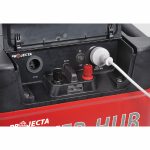The Projecta Power Hub is a versatile and reliable power management solution for a variety of applications. However, like any piece of technology, it can encounter issues from time to time. This troubleshooting guide will help you identify and resolve common problems with your Projecta Power Hub.
Understanding the Basics
Before diving into specific issues, it’s important to understand the basic components and functionalities of the Projecta Power Hub. The device typically includes multiple power outlets, USB ports, and possibly other connection points for different types of equipment. It also features indicators and buttons for monitoring and controlling the power flow.

Common Issues and Troubleshooting Steps
In this section, we will cover the most common issues users face with the Projecta Power Hub and provide step-by-step troubleshooting instructions.
Power Hub Not Turning On
One of the most common issues is the Power Hub not turning on at all. Here are some steps to troubleshoot this problem:
- Check the Power Source: Ensure that the power cord is properly connected to both the Power Hub and the wall outlet. Verify that the wall outlet is functioning by plugging in another device.
- Inspect the Fuse: The Power Hub may have an internal fuse that could be blown. Refer to the user manual to locate and check the fuse. Replace it if necessary.
- Reset the Device: Some models have a reset button. Press and hold this button for a few seconds to see if the device powers up.
- Battery Backup: If your Power Hub has a battery backup, ensure that the battery is charged and properly installed.
Devices Not Charging
Another common issue is when connected devices are not charging properly. Follow these steps to troubleshoot:
- Check Connections: Ensure that all devices are securely connected to the Power Hub.
- Verify Outlet Functionality: Test different outlets on the Power Hub to see if the issue is with a specific port.
- Examine Cables: Faulty cables can often be the culprit. Try using different cables to see if the devices start charging.
- Power Rating: Make sure the devices you are trying to charge are within the power rating of the Power Hub. Overloading the Hub can prevent devices from charging.
Find how to charge Power hub properly here >>
Intermittent Power Supply
If you experience intermittent power supply from the Power Hub, these steps may help:
- Loose Connections: Check all connections to ensure they are tight and secure.
- Overheating: The Power Hub might be overheating. Ensure it is placed in a well-ventilated area and not covered by other objects.
- Firmware Update: Some models may require a firmware update. Refer to the user manual for instructions on how to update the firmware.
- External Interference: Ensure that there are no strong electromagnetic sources near the Power Hub that could be causing interference.
Indicator Lights Not Working
Indicator lights are essential for monitoring the status of the Power Hub. If they are not working, consider these troubleshooting steps:
- Check Power Source: Ensure that the Power Hub is receiving power.
- Inspect LEDs: The LEDs themselves may be faulty. If possible, test with a multimeter or consult customer support.
- Circuit Board Issues: There could be a problem with the internal circuit board. This may require professional repair or replacement.
Overload Protection Engaged
The Power Hub is equipped with overload protection to prevent damage. If this feature is engaged, follow these steps:
- Disconnect Devices: Unplug all devices from the Power Hub.
- Reset the Hub: Press the reset button if available. Some models may require you to unplug and then plug back in the power cord.
- Gradual Reconnection: Reconnect devices one at a time to identify if a specific device is causing the overload.
USB Ports Not Working
If the USB ports are not functioning, here are some steps to troubleshoot:
- Test with Different Devices: Connect different devices to the USB ports to see if any of them work.
- Inspect for Damage: Look for physical damage to the USB ports.
- Check Power Allocation: Some Power Hubs allow you to manage power distribution. Ensure that the USB ports are receiving adequate power.
- Firmware Update: Updating the firmware may resolve USB port issues.
Preventive Maintenance
To keep your Projecta Power Hub in good working condition, consider these preventive maintenance tips:
- Regular Cleaning: Dust and debris can accumulate in the ports and vents. Clean the Power Hub regularly with a dry cloth and compressed air.
- Avoid Overloading: Do not exceed the power rating of the Hub. Always check the power requirements of your connected devices.
- Proper Ventilation: Ensure that the Power Hub is placed in a well-ventilated area to prevent overheating.
When to Seek Professional Help
If you’ve tried all the troubleshooting steps and your Power Hub is still not working correctly, it might be time to seek professional help. Contact Projecta customer support or take the device to a certified technician for further diagnosis and repair.
Conclusion
Understanding and troubleshooting common issues with your Projecta Power Hub can save you time and frustration. By following the steps outlined in this guide, you can resolve many problems on your own. However, don’t hesitate to seek professional assistance if needed. Proper maintenance and care will ensure that your Power Hub continues to provide reliable power management for all your devices.
Remember, always refer to the user manual for specific instructions and safety guidelines related to your model of the Projecta Power Hub. This guide serves as a general troubleshooting resource but may not cover every unique aspect of your device.
By staying informed and proactive, you can make the most out of your Projecta Power Hub and enjoy uninterrupted power for all your essential devices.




